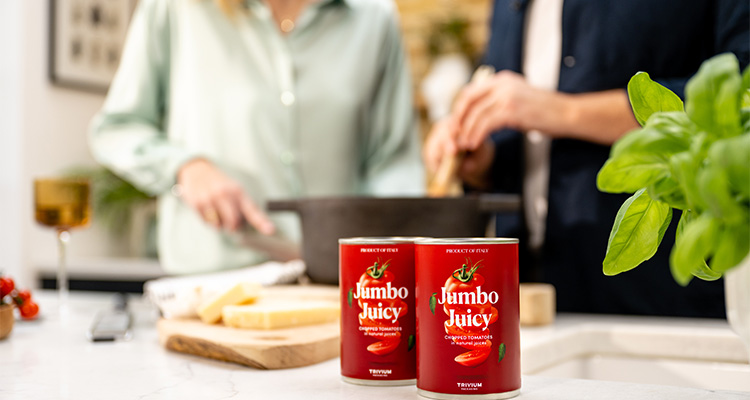Beyond single use: the changing role of convenience food packaging
The issue of single-use plastic waste remains a major concern for consumers and retailers alike, specifically in the convenience food sector. It is estimated that the amount of plastic flowing into the ocean could triple between 2016 and 2040. To combat this ever-pressing issue, the UK government recently set a target to end plastic pollution by 2040 by creating a legally binding international treaty that involves cooperation between businesses and environmental organizations.
Given the convenience food market is expected to grow annually by three percent – an opportunity exists for brands to make headway sooner by helping to reduce packaging waste throughout the market.
The packaging waste issue
Convenience food, available in its various forms, provides a significant opportunity to reduce packaging waste. From dairy products, ready-made sauces, spreads, and drinks, to frozen oven-ready meals, supermarkets display plastic-wrapped convenience foods in nearly every aisle.
It is predicted that by 2027, this sector will generate 14.3 million kilograms of food, resulting in the potential for substantial packaging waste. Unfortunately, much of this waste is plastic, which can only be recycled two-to-three times, with low recyclability rates of 49 percent in the UK and 38 percent in the EU. A study found that eight out of ten of the 12 million pieces of litter analysed from around rivers, oceans, shorelines, and the seafloor were made of plastic – 44 percent of that litter was related to convenience food and drinks. With demand high, now is the time for the industry to look at the packaging used and start thinking about alternatives.
 Exploring sustainable alternatives to traditional packaging
Exploring sustainable alternatives to traditional packaging
For brands, choosing the right packaging is vital. It requires a lot of time and investment as there are several factors to consider. With the main goal of convenience food being its functionality, packaging in this area should be designed to reduce the risk of damage and food waste during storage, handling, and consumption while also being easy to eat, with minimal effort for the on-the-go consumer.
In contrast, when it comes to ready-to-cook meals, customers are drawn to visually appealing containers that can also be used as serving dishes. This provides a quick and attractive packaging solution that minimizes effort from preparation to serving and consumption with easy clean-up.
As the Protect, Promote, Preserve whitepaper explains, choosing the right packaging is a decision to which brands will often dedicate considerable time. Many companies within the food industry have therefore opted to enclose their products in metal cans, a type of packaging offering superior levels of robustness and durability relative to alternatives on the market.
Metal packaging can Protect contents from external elements, such as UV light and moisture, Promote the brand’s differentiation and consumer messaging and Preserve natural resources of food. Experts note that the gold standard of sustainability for packaging is its recyclability. Metal packaging offers superior circularity compared to plastic and multi-layer substrates, which cannot be infinitely recycled. The complexity of substrates not made of a singular material also makes the recycling process challenging.
Additionally, brands recognize that metal packaging can be an effective brand tool. With advanced graphics and prominent colours, they can use the entire surface area of cans and bottles without sacrificing functionality or recyclability. Metal printing is safe for food products, meeting strict food safety regulations due to the impermeability of metal and the use of compliant inks.
The future is bright
In recent times, customers have become increasingly environmentally conscious and tend to make purchasing decisions based on their eco-friendly preferences. The Buying Green Report 2023 shows that up to 63 percent of consumers hesitate to buy products with packaging that is harmful to the environment, and around three-quarters of consumers are willing to pay more for sustainable packaging. Additionally, a new finding in the same report showed that on average, 35 percent of respondents perceive food and beverage products to be in sustainable packaging today, while 82 percent expect to purchase more sustainable products in the future.
Choosing sustainable materials is not only the right thing to do, but it will also soon be required by law in many countries. For example, the United Nations created a treaty to regulate plastic use globally, and the EU plans to pass new rules by 2030 that will require packaging materials to be easier to recycle. Similarly, the UK will ban many single-use plastics by October 2023.
Given consumers’ increasing reliance on convenience foods, there is potential for this sector to make a significant contribution to packaging circularity by embracing a sustainable alternative. Metal’s true circularity gives it a unique role in helping to protect the planet for generations to come. There is a real opportunity here to not only tackle the waste issue head-on but showcase new innovative ways of thinking when it comes to packaging – setting a standard that other sectors can replicate.
For a list of the sources used in this article, please contact the editor.
Ajeeth Enjeti
Ajeeth Enjeti is General Manager EU Food at Trivium Packaging. Trivium Packaging is a global leader in sustainable metal packaging known for creating innovative and unique infinitely recyclable, reusable and refillable solutions for some of the world’s most well-known brands. Trivium has more than 60 locations worldwide and employs close to 7500 people with sales of $3.3bn.
